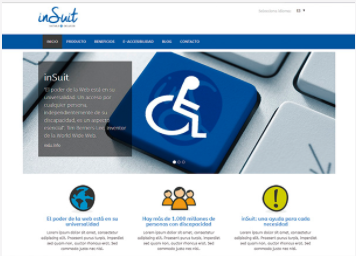
inSuit is once again included in the Gartner® Market Guide for Digital Accessibility
8 September 2025

The paradigm of mandatory web accessibility will shift from being a voluntary best practice to becoming a legal requirement, marking a turning point in the digital landscape.
This transformation will affect both the private and public sectors, establishing strict requirements to ensure that everyone can access digital services and products without barriers, with financial penalties of up to €1 million depending on the severity of the breach.
To date, many organizations have approached web accessibility as a voluntary initiative based on best practices, with no legal consequences for non-compliance.
However, in Europe, the landscape will change radically from June 28, 2025, when mandatory legal accessibility will require the private sector to comply with specific requirements established by the European Accessibility Act (EAA), adding to the regulations of Member States under the WCAG 2.2 guidelines.
For the first time in the history of European accessibility legislation, non-compliance will result in real and significant penalties, unlike previous legislation that lacked effective enforcement mechanisms.
This transition responds to the growing digitization of essential services, which has highlighted the need to ensure equal access for all users.
This is also the case in Latin America, where regulations set the standard and requirements for digital accessibility in the different countries that make up the region. The aim is to ensure the elimination of barriers in the online world so that we can take full advantage of everything the digital environment in which we currently operate has to offer.
Digital accessibility is a fundamental pillar of social inclusion, recognized by the United Nations Convention on the Rights of Persons with Disabilities as a basic human right.
However, it is important to note that these regulations do not exclusively benefit people with disabilities, but also other vulnerable groups such as the elderly and people with limited technological skills.
This is why mandatory compliance is based on the recognition that equality and equal opportunities are guaranteed through non-discrimination and universal accessibility.
Furthermore, mandatory web accessibility, viewed from a productive and even business development perspective, can increase conversion rates by up to 15% in e-commerce businesses simply by complying with established accessibility guidelines, demonstrating that it is not only ethically correct but also strategically beneficial.
For public administrations, mandatory web accessibility requirements are not entirely new. The regulations of each European Union country already establish specific requirements for the entire public sector.
These bodies must ensure that their websites and mobile applications are “perceptible, operable, understandable, and robust,” complying with the standard and based on WCAG 2.1 level AA.
In addition, they require periodic reviews, follow-up reports, and the provision of channels for users to report access barriers. The implementation of these obligations involves complex technical tasks, ranging from accessibility audits to the constant updating of content and functionalities.
It is therefore essential to have the support of accessibility experts and specialized developers, who can facilitate the correct interpretation of the regulations and the implementation of effective solutions.
This previous experience in the public sector undoubtedly serves as a reference for private companies now facing similar obligations.
Although regulations establishing accessibility obligations for private companies already exist, such as the European Accessibility Act, the new law tightens and broadens the regulatory framework in terms of both the number of requirements and the scope of companies affected.
Until now, obligations may have seemed limited to certain sectors or large companies, but the new law introduces much stricter requirements and covers a considerably broader spectrum of businesses.
Virtually any organization that offers digital products or services to the public could be required to comply with the new accessibility standards, regardless of its sector or size, with very few exceptions.
This means that many companies that were not previously considered affected will need to carefully review their situation and prepare to adapt to the regulations.
The new legislation establishes the obligation to adapt both new and existing digital products and services within deadlines that vary according to the nature and age of each one.
In this context, it is essential that companies do not assume that they are exempt from these obligations. Web accessibility is no longer an optional issue or one limited to large corporations: it has become a cross-cutting challenge that affects the vast majority of the European business fabric.
Certain sectors face particular requirements due to their importance in everyday life. E-commerce must ensure accessible purchasing processes, with perceivable information and operable navigation on their digital platforms.
Banking and financial services must ensure that all their consumer services, including apps and websites, are fully accessible.
The transport sector presents unique challenges, as websites, apps, e-tickets, and interactive terminals for air, rail, sea, and road services must strictly comply with regulations.
Other sectors such as telecommunications, audiovisual communication services, electricity, water and gas supply, as well as travel agencies, are also specifically covered by the legislation.
The definitive turning point will come on June 28, 2025, when the European Accessibility Act will fully enter into force in all European Union countries.
This directive, also known as Directive (EU) 2019/882, has followed a gradual process: June 28, 2022, was the deadline for all member states to integrate the EAA into their national legislation, while the same date in 2025 marks the moment when supervisory bodies will begin to enforce the regulations.
The technical pillar of all web accessibility regulations is the WCAG standard, currently in version 2.2, although the legislation still officially references version 2.1.
This standard establishes 86 criteria divided into three levels of compliance: Level A (basic requirements), Level AA (mandatory by law in Europe and Spain), and Level AAA (desirable but not legally required).
European legislation specifically requires compliance with Level AA, which means meeting all the criteria of Levels A and AA in order to be in compliance with the regulations.
It is crucial to remember that the W3C has stated that complying with the requirements of WCAG 2.2 guarantees full compliance with the standards established in WCAG 2.1.
European Standard EN 301549:2021 specifies the functional accessibility requirements applicable to ICT products and services.
Although it is largely based on WCAG 2.1, it includes additional requirements that go beyond this standard, so compliance with WCAG 2.1 does not automatically guarantee compliance with this standard.
Since 2018, websites must include a mandatory accessibility statement that must be accessible from all pages of the site, updated annually in September, include the level of compliance, non-accessible content, date and methods of evaluation, and provide a complaint mechanism for users to report barriers.
The transformation of web accessibility from a recommendation to a legal obligation represents one of the most significant changes in the European digital ecosystem.
This evolution not only establishes a stricter regulatory framework, but also recognizes digital accessibility as a fundamental right in the age of digitalization.
Organizations that get ahead of these requirements will not only avoid significant financial penalties, but will also position themselves favorably in a market that increasingly values inclusion and corporate social responsibility.
The successful implementation of these measures will require a comprehensive approach that combines technical, legal, and organizational aspects, but the result will be a more inclusive and accessible digital environment for all European citizens.